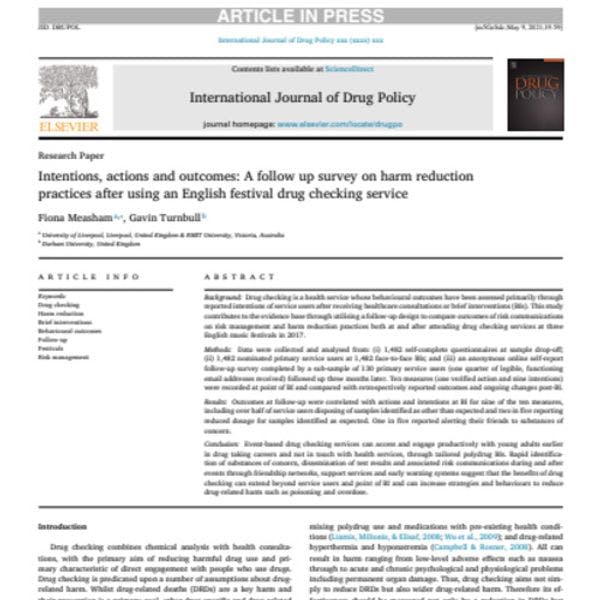International Journal of Drug Policy
Intentions, actions and outcomes: A follow up survey on harm reduction practices after using an English festival drug checking service
By Fiona Measham & Gavin Turnbull
Drug checking combines chemical analysis with health consultations, with the primary aim of reducing harmful drug use and primary characteristic of direct engagement with people who use drugs. Drug checking is predicated upon a number of assumptions about drugrelated harm. Whilst drug-related deaths (DRDs) are a key harm and their prevention is a primary goal, other drug-specific and drug-related harms arise for individual users and wider society from adulteration, misselling and variations in strength, that are the focus here. For example, overdose can result from 25x-NBOMe missold as LSD (Martins et al., 2017; Measham, 2020); anxiety, paranoia and psychosis from potent cathinones such as Nethylpentylone missold as MDMA (Measham & Jones, 2017); severe toxicity from high dosage (Black et al., 2020); from mixing polydrug use and medications with pre-existing health conditions (Liamis, Milionis, & Elisaf, 2008; Wu et al., 2009); and drug-related hyperthermia and hyponatremia (Campbell & Rosner, 2008).
All can result in harm ranging from low-level adverse effects such as nausea through to acute and chronic psychological and physiological problems including permanent organ damage. Thus, drug checking aims not simply to reduce DRDs but also wider drug-related harm. Therefore its effectiveness should be measured not only by a reduction in DRDs but by successful risk communications that enhance risk management and increase harm reduction practices. By reducing adverse effects such as accidental poisoning and overdose, it is hoped that accessing emergency services, requiring medical intervention and admission to hospital will all be reduced. However, as with other harm reduction interventions, the aim is not to eliminate harm – so long as drug use remains a possibility, so too does drug-related harm – but to identify substances of concern in circulation and to increase strategies, behaviours and risk communications that could reduce that harm.
Evidence highlights the value of disseminating test results obtained from both publicly accessible drug checking and also non public drug testing (eg Johnson, Stansfield, & Hassan, 2020), for trend monitoring, public information alerts and early warning systems (eg Brunt & Niesink, 2011; Bücheli, Hungerbühler, & Schaub, 2010), However, a “limited” evidence base on individual behavioural outcomes of drug checking has been noted (EMCDDA, 2017: 139), and there is an absence of randomised controlled trials, longitudinal studies or follow-up studies. Opportunities to compare drug checking outcomes at regional and national level are also limited, with Leece (2017), Measham (2019) and Measham (2020) noting constraints such as legal, political and commercial sensitivities. A further practical obstacle to evaluation of eventbased drug checking services is the non-standardised and resourceintensive nature of collecting data from individual event management, support services and other agencies in order to monitor trends in drugrelated incidents.
